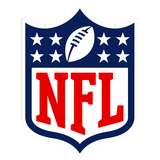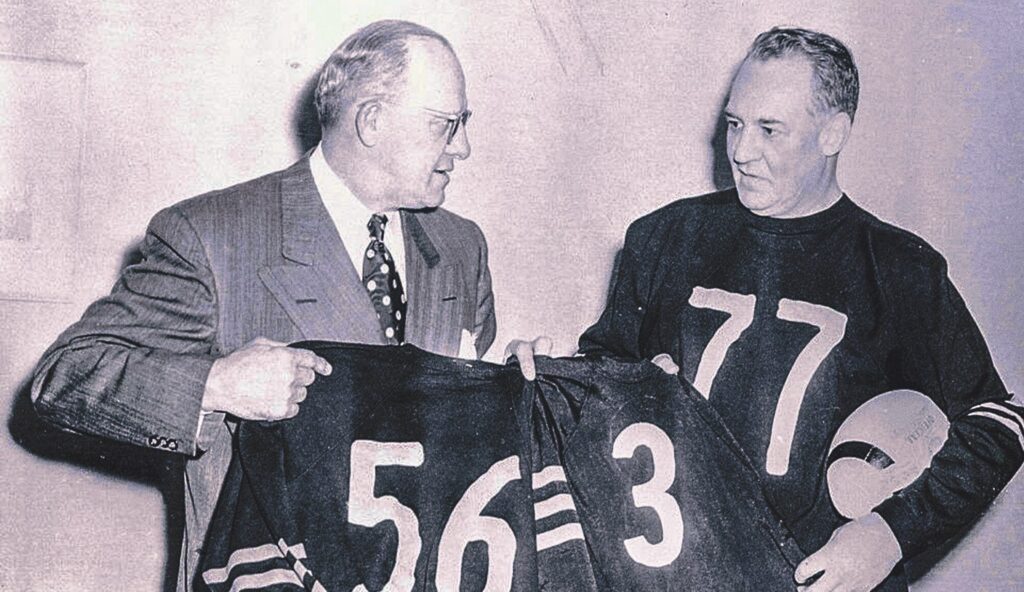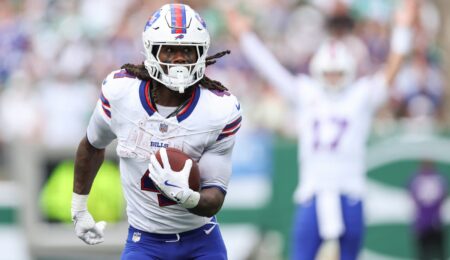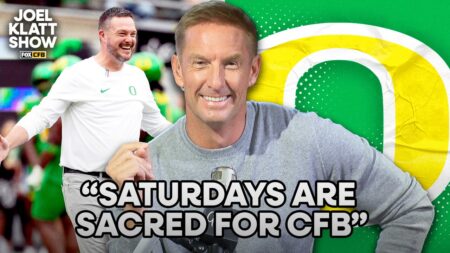Ralph Vacchiano
NFL Reporter
When fans settled into Knights of Columbus Stadium in East Orange, New Jersey, back in 1929 to watch their new NFL team in action, it was easy for them to pick out their favorite players. But it wasn’t because of the numbers on their jerseys.
The players on the Orange Tornadoes actually wore letters on their backs.
It was weird and never quite caught on — nobody is known to have purchased an “E” jersey to honor quarterback George Pease — and it lasted only a year. But it was a reminder that jersey numbers weren’t always a sports staple. In fact, there was a time when fans really couldn’t tell one player from another in the NFL — even with a scorecard.
As quarterback and captain for Columbia University, George Pease wore a number, but when he first joined the NFL, he wore the letter E. (Photo by George Rinhart/Corbis via Getty Images)
That’s because, while the amateur Detroit Heralds put numbers on their jerseys in 1905 as a way to spark fan interest in their players, the NFL only suggested teams use numbers when it formed in 1920. It took several years before every team followed suit, so to speak.
Finally, by the end of the 1920s, all NFL players had numbered jerseys, which rarely went higher than No. 25, based on rosters capped at 22 players. There were a few notable exceptions, like Bears star halfback Red Grange, who was allowed to wear 77, the number he wore in college at Illinois. (That’s the Galloping Ghost in the banner photo above along with Bears founder George Halas.)
As NFL rosters expanded, the league’s numbering system went on a wild ride.
In fact, until 1952, there was no “system” at all. Players could generally take whatever number they wanted — or, more accurately, the number they were assigned by their team. But in 1952, the NFL adapted the system that had already been used in college football for years, with players — most of whom played on both sides of the ball — getting numbers that loosely correlated to their offensive position. The backs (who often played defensive back on defense) received numbers between 10 and 49. The offensive linemen (who would then also play defensive line) wore numbers from 50-89.
That was the extent of the NFL’s system, which weirdly omitted fullbacks and tight ends (linebackers on defense), who were free to choose any numbers. The ends (receivers) also had free numerical rein, though they usually took numbers in the 80s, which they wore when they played defensive back, too.
That very loose system lasted until 1973, when the NFL, fresh off its merger with the AFL, implemented a strict system with rigid rules for numbers of players at certain positions. As rosters expanded even more over the next 50 years — and as more numbers were officially or unofficially retired by teams — the NFL made several adjustments. But it generally kept the system that has become familiar to a generation of players and fans: kickers in the single digits, quarterbacks from 10-19, running backs and defensive backs in the 20s and 30s, linebackers in the 40s and 50s, offensive linemen in the 60s and 70s, receivers and tight ends in the 80s and defensive linemen in the 90s.
The league also banned the use of No. 0 or No. 00 in 1973, though only three players in NFL history had worn each of them. The last was Raiders Hall of Fame center Jim Otto, who was allowed to continue wearing the number that spherically matched the letters at both ends of his last name.
Jim Otto wasn’t about to give up No. 00 when the NFL implemented new numbering rules in 1973. (Digital First Media Group/Oakland Tribune via Getty Images)
In 2021, the NFL changed the rules again, giving players the freedom of numerical expression that they clearly desired. Two years later, the league even cleared players to wear No. 0 — but not 00 for some reason — for the first time in 50 years. Then-Jaguars receiver Calvin Ridley became the first of more than a dozen NFL players in the past few seasons to don the zero, including Bears running back D’Andre Swift and Giants edge rusher Brian Burns.
And with that change, the NFL finally landed on the very broad, but still somewhat rigid, numbering system of today:
Quarterbacks: 0-19
Punters/kickers: 0-49, 90-99
Defensive backs: 0-49
Running backs/tight ends/receivers: 0-49, 80-89
Offensive linemen: 50-79
Defensive linemen: 50-79, 90-99
Linebackers: 0-59, 90-99
(Designated long-snappers are free to wear any number, though the number they choose would dictate any other position they’re allowed to play during a game).
That system is so broad that you really do need a scorecard to tell the players apart, since a player wearing Nos. 0-49 could play literally any position, as long as he doesn’t line up on either line. But at least they’re no longer wearing letters — except for the “C” on the chest of team captains.
That protects the legacy of the 1929 Orange Tornadoes, including end and tackle Johnny Tomaini, who remains the lone player to wear an NFL jersey with the letter X.
Ralph Vacchiano is an NFL Reporter for FOX Sports. He spent the previous six years covering the Giants and Jets for SNY TV in New York, and before that, 16 years covering the Giants and the NFL for the New York Daily News. Follow him on Twitter at @RalphVacchiano.
Want great stories delivered right to your inbox? Create or log in to your FOX Sports account, follow leagues, teams and players to receive a personalized newsletter daily.
recommended

Get more from the National Football League Follow your favorites to get information about games, news and more
Read the full article here











